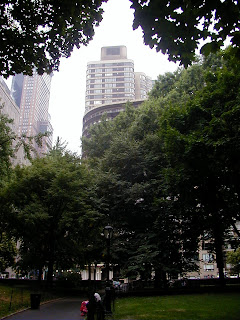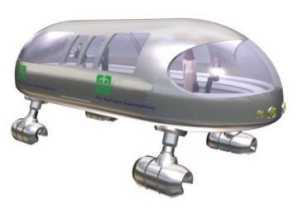Moving Minds is the theme of this year's SMART conference at the University of Michigan (UMich). SMART is "Sustainable Mobility & Accessibility Research & Transformation", a project of CARSS, the Center for Advancing Research and Solutions for Society at the University of Michigan in Ann Arbor. I'll be passing along the highlights of the conference for you, day by day.
This was our first session. What's Pecha Kucha? It turns out it's the Japanese expression for "yackety-yak" or "yadda-yadda". The idea is to present a creative idea through a short, image-intensive presentation. (PowerPoint on steriods?) The limit here was 5 minutes. Of course, this won't make much sense without seeing the images, but I hope this will give you an idea what to look into more... I'll revisit this and add links to all the presentations SMART makes available on the Web.
What floated to the surface of this intense session? With so much being presented, everybody will have picked up something different. Here's what floated my way:
Changes in population and energy availability make for an extremely complex mobility problem, or rather, series of problems. There are no magic bullets (though there may be "magic buses"!). Rather, the solution lies in a combination of ingenuity and telecummunications, taking into account the needs of the diverse humans who need access to jobs, food, and entertainment.
Want to sample tidbits? OK, here goes...
GLOBAL MEGA-FORCES: Tom Gladwin, UMich
We seem to expect super-technical advances to solve our problems, but... Climate change, water availability, ecosystem health, population size, poverty prevenence, and urbanization are the mega-forces to confront. Interactions are complex, but climate change is the major driver. Climate refugees move to urban areas (slums) around the world, and all are poor, if not desperate.
ENERGY FOR TRANSPORTATION: Sue Nichols UMich Phoenix Memorial Lab.
Nothing is simple! What you love one minute, the next minute seems to have a lot of problems (the "Britney Spears effect" LOL!). Energy solutions need to be wholistic. Human nature resists change, and we get NIMBY, BANANA, and NOPE attitudes.
ACCESSIBILITY: Jonathan Levin, UMich Department of Urban and Regional Planning
Stats on who drives most shows per capita is related to population density. The purpose of transportaiton is not movement, but access. Accessibility = meeting our needs through mobility, proximity, or connectivity. Rather than measure vehicle miles traveled, a better measure of urban transportation is a rather complex formula encompassing distance and destinations such as jobs, entertainment, and life necessities.
SOCIAL JUSTICE AND TRANSPORTATION: Joe Grengs, UMich Department of Urban and Regional Planning
Social injustice: anything that holds back a person from reaching their full potential. People who live without cars in our auto-oriented world are largely invisible to us. What to do? Change land development patterns; measure accessibility. We need to see cities as made up of multiple worlds - not all from a dominant-group perspecive.
NEW MOBILITY AND INCLUSIVE GOVERNANCE: August Mathias, Advisor, National Confederation of Municipalities of Brazil
When government doesn't provide needs, people will take it into their own hands. the planning process should involve the people for whom the planning is being done, changing to a flexible, innovative, decentralized decision making process
TRANSIT-ORIENTED DEVELOPMENT: Deena Fox, Architect, Rossetti of Detroit
What is TOD? Walkability, connectivity, diverse and dense mix of uses, diversity of housing types oand price points; quality architecture, sustainable communities with good access to transit. Transit drives real esate development, producing a dynamic, memorable environment.
COMMITMENT TO HIGH SPEED RAIL NETWORKS IN SPAIN: Robert Polk, Former Director, Detroit DOT.
Mr. Polk was very impressed by Spain's commitment to high speed rail. They have invested $116B in HSR, or 1.5% of their GDP. An interesting fact: 0.1% of greenhouse gasses in Europe are emitted by trains, 3% by airlines, and 15% by road trafic.
BIKESTATION: Andrea White-Kjoss, Mobis Transportation
BikeStation provides sustainable "last mile"transportation linked to transit - bike parking, changing, showers, repair for bikes; e-accessible. Thirty bikes can park in the space of 1 car at their Washington DC Union Station site. "...not what it provides, but what it makes possible" - Secretary of Transportation Ray LaHood, about the DC BikeStation.
500,000 TONS: Robin Chase, ZipCar
There are 325,000 members of ZipCar, using only 6,500 cars. Each normal (non-Zip) car requires 3 parking spaces (work, home, leisure), while a ZipCar requires only one. Robin estimates there is a 93% reduction in automobile usage (emissions, fuel use, parking...) among ZipCar members, 40% of whom do not own a car, due to change in driving habits. Paying for the car by the hour encourages more efficient habits, resulting in saving 500,000 tons of carbon emissions.
LESSONS FROM THE SLUG LINES -FLEXIBLE CARRPOOLING: Paul Minett, Trip Convergence Ltd.,
their goal is to "make it easier and more rewarding for people to share rides." In the San Fransicso Bay area and the DC area, there are informal ridesharing systems known in DC as "slug lines". People line up in designated places, like the BART station in Berkeley, and are picked up by people with cars who can save time and money crossing Bay Bridge into San Francisco. Paul observed 116 carpools being formed in 1 hour in Berkeley. 9,000 people in Bay Area use flexible carpooling each day. In DC "Slug Lines", 2,000 riders per day get to the Pentagon. Trip Convergence is setting up a new project in Seattle, aiming for more efficient organization.
AUTONOMY: Jeffrey Adik, Intraduce, on personal transportation and goods movement.
This hyper-slick presentation pushed automatic vehicles. Lots of graphs of several mentions of the Department of Defense were thrown at the audience, but not much of a coherent or realistic program.
DELIVERING THE GOODS IN CITY REGIONS: Sue Zelinski, UMich SMART Program
Goods movement is our teacher especially in Japan and Germany. Supply chain efficiencies; moving less stuff less far; reducing the impact of trips by using last-mile bike and foot couriers.
TDM AND TECHNOLOGY: Alan Huynh, University of Southern California, Urban Planning major
TDM = Transportaiton Demand Management, encouraging people to use alternative modes of transportation rather than build more highways. Alan spoke of the convergence of social media like Facebook, mobile technology, and Web 2.0 making transportation more personal; there are no cookie-cutter solutions, and it necessary to be sensitive to the culture of a region. But using technology can help bypass the mires of bureaucracy.
MAGIC BUS TECHNOLOGY PLATFORM: Adrian Fontino, Shepherd Intelligent Systems
Shepherd (SIS) is a spin-off of UMich; their system has been running 4 years on UM buses, now tracking AATA Route 6 (my route!!). They're working to solve what extensive research (and commonse sense) say are the toughest problems in getting people to feel comfortable using public transportation: Navigating unfamiliar cities; never know "when the damn bus will come!"; can't find the best way to travel from point A to point B via public transportation. Solution: great SIS algorithms for predicting bus arrival times!
EXCESS CAPACITY: Robin Chase reprise
ZipCar does for cars what hotels do for beds. Add open platform Web technology, and we'll get something like CouchSurfing for transportation! We need open devices, open data, open networks, engaging the common man.
GET DOWNTOWN: Nancy Shore, Ann Arbor Get Downtown
New Mobility hub network - people are what drive transportation; we need to help them integrate their transportation. Where do transportation modes intersect? (Parking, bus, bike storage, etc.) Those are hubs, and should be marked on maps along with bus stops.
THE PERSONAL VEHICLE: Dan Sturges, Intrago
Last-mile mobility, hybrid of personal vehicle and transit. 80% of people have trouble getting to a transit stop. Dan has designed several "Neighborhood vehicles"; A related venture, ItMoves, is working to provide a "mobility bundle" to help people get where they need to go by transit.
NEW MOBILITY HUB NETWORK CHECKLIST: Raj Cherubal
Lack of knowledge on the part of the public is frustrating. How do you multiply the benefit of transit? Raj proposes a quick checklist to engage designers in multi-modal transportation and prevent the many specialists from overlooking essential details unfamiliar to them.
MOADL (MOBILITY OPEN AMBIENT DATA LANGUAGE): Kyle Lawson
This is a proposed standardized way to organize and retrieve mobility information, that can be utilized within applications.
NEW MOBILITY AND USABILITY:Ilona Posner
Challenge: we spend a lot of effort building a product, but the user connection is often left as an afterthought. Usability guarantees the success. Enter, USER-CENTERED DESIGN, balancing needs of users, business, and technology. (This has been applied to lots of products, and we need to apply it to mobility design.) BTW, Ilona checked Google Maps, as we all do, to find the meeting venue: 100 Washtenaw Ave., Ann Arbor, MI. Try it - Google will take you to Ypsilanti instead!
HUMAN CENTERED DESIGN: Barbara Knecht, Institute for Human Centered Design, Boston
Meet the 21st century human for whom we are designing new mobility systems. Social sustainability! Not all humans are created equal, and as medical advances make a productive life for people who formerly would not have lived, we need to design mobility systems to meet their needs.
AFRICAN COUNTRIES - THE FRONTIER OF SUSTAINABLE ABNORMAL PROFITS: Andrew Russell, CEO of Kab Shuttle, Cape Town
Rather than talk about the Kab Shuttle enterprise, Andrew delivered a sales pitch for investment in Africa. Not too credible in certain respects, but perhaps some South Africans are desperate to get non-Chinese investment?



 The economy is bad. But it's not like that all over the country. I subscribe to Rail magazine, ("Connecting Communities by Moving People") whose current issue features articles on five regions that have recently inaugurated new rail service. All are very much like what Wake Up Washtenaw has been proposing for the rail line north and south of Ann Arbor: (1) use a freight rail line that sees little freight traffic or has been abandoned, and (2) use diesel multiple-unit cars (DMUs). These paragraphs really jumped out at me in the article about Austin, Texas's, new MetroRail:
The economy is bad. But it's not like that all over the country. I subscribe to Rail magazine, ("Connecting Communities by Moving People") whose current issue features articles on five regions that have recently inaugurated new rail service. All are very much like what Wake Up Washtenaw has been proposing for the rail line north and south of Ann Arbor: (1) use a freight rail line that sees little freight traffic or has been abandoned, and (2) use diesel multiple-unit cars (DMUs). These paragraphs really jumped out at me in the article about Austin, Texas's, new MetroRail:  But of course, nothing like this could happen here in Michigan, right? We're too dedicated to being left behind. No sense investing our dollars in a sinking state. *Sigh*
But of course, nothing like this could happen here in Michigan, right? We're too dedicated to being left behind. No sense investing our dollars in a sinking state. *Sigh*






